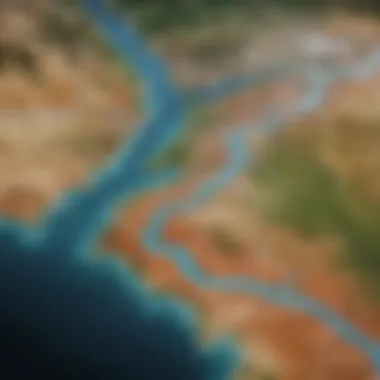Understanding Hydrological Maps: Their Importance and Applications


Intro
Hydrological maps serve as crucial tools in comprehending water distribution across different terrains. They are not just colorful illustrations; they encapsulate vital information about various water resources. Through these maps, researchers and urban planners glean insights into rain patterns, river flows, and groundwater levels, all of which are essential for managing water resources effectively.
In today's context, where climate change is an ever-looming threat, understanding hydrology has taken on a new significance. These maps help predict flood zones, track drought areas, and inform decisions regarding the allocation of water supply. As populations grow and urban sprawl expands, the need for accurate mapping of water resources becomes increasingly pressing.
Hydrological maps come in various forms—some highlight surface water, while others focus on groundwater or watershed boundaries. The intricacies involved in creating these maps hint at the convergence of disciplines such as geology, meteorology, and environmental science, providing a rounded perspective on water resource management.
In this exploration, we will examine not only the types and methodologies of these maps but also how technological advancements, such as remote sensing and GIS, have revolutionized the way we understand and interpret hydrological data. Understanding hydrological maps opens the door to better environmental stewardship, ensuring that practitioners from various fields can make informed decisions in their respective domains.
Prelims to Hydrological Maps
Understanding hydrological maps is not just a matter of curiosity; it’s a critical area of study for anyone interested in environmental science, urban planning, or disaster management. Hydrological maps provide a visual representation of the flow and distribution of water within our ecosystems. They serve as essential tools for water resource management, ecological research, and urban development. Without such maps, decision-makers would flounder in a sea of data, struggling to grasp how water interacts with geography.
The significance of these maps extends beyond mere depiction. They facilitate informed decisions concerning water conservation, flood management, and resource allocation. When scientists, policymakers, or activists want to make a case about the importance of preserving a watershed or managing stormwater, hydrological maps become invaluable tools. With their ability to visualize complex data clearly, they help stakeholders understand spatial patterns, trends, and anomalies that might otherwise be obscured by raw data.
Definition and Importance
At its core, a hydrological map illustrates various water bodies—rivers, lakes, and reservoirs—as well as the connections among them and their relation to the surrounding environment. They can focus on precipitation patterns, groundwater levels, or even pollutant dispersion.
These maps are crucial in evaluating how water sources affect surrounding ecosystems and human communities. They function as authoritative documents that guide policy decisions and action plans, making them indispensable within the realms of environmental management and scientific inquiry. Owning a proper hydrological map means having access to the lifeblood of the area—literally and metaphorically.
Historical Background
The tradition of mapping hydrological features can be traced back many centuries, with early examples emerging from civilizations that depended heavily on rivers for agriculture and commerce. Ancient Egyptians, for instance, recorded the annual flooding of the Nile River, embedding that information in maps and hieroglyphics. Over time, techniques evolved; in the 17th century, John Evelyn published works emphasizing the importance of water management, paving the way for more systematic and scientific approaches.
Technology has further shaped the development of hydrological maps. The advent of aerial photography in the early 20th century gave rise to more accurate representations, while the later introduction of satellite imagery has taken it a step further. Today, such maps rely on advanced techniques that integrate various data sources, benefitting from the rapid growth of computational technologies.
Contextual Relevance in Modern Science
In modern scientific discourse, hydrological maps have become a focal point for discussions around climate change, urban development, and sustainable practices. As climate patterns fluctuate, the need for updated maps ensures effective planning and response strategies. These maps also shed light on emerging issues such as water scarcity, pollution, and the impacts of land-use changes over time.
Moreover, in research settings, hydrological maps facilitate comparative studies across regions by providing context for environmental changes. They are vital in examining the intersection of human activity and natural processes, allowing researchers to plot trajectories and make predictions based on evidence. It’s safe to say that the realm of hydrology—a field that is both intricate and profoundly important—would face significant challenges without the aid of hydrological maps.
Components of Hydrological Maps
Hydrological maps serve as a critical tool for visualizing and analyzing water flow and distribution in various geographical areas. The components of these maps bring together different elements that depict the nuances of water systems in a coherent manner. By synthesizing various aspects of the hydrological cycle, data variables, and the symbols used for representation, practitioners and researchers can extract meaningful insights into water resources management. Understanding these components equips one with the knowledge to make informed decisions about environmental sustainability and resource allocation.
Water Cycle Representation
The water cycle is a fundamental concept in hydrology that illustrates the continuous movement of water on, above, and below the surface of the Earth. Hydrological maps often represent this cycle through various features—precipitation areas, surface runoff paths, and groundwater infiltration zones are just a few.
- Precipitation Zones: Regions are highlighted where rainfall collects, informing agricultural planning and stormwater management.
- Surface Runoff Pathways: Shows how water flows over land, which is crucial during flood risk assessment.
- Groundwater Recharge Areas: Identifies areas where water seeps into the ground, which can impact long-term aquifer sustainability.
Overall, the depiction of the water cycle in hydrological maps allows for a visual understanding of where water is sourced, how it travels, and where it is stored in different seasons. This holistic view can enhance disaster planning and environmental protection efforts.
Data Sources and Variables
To create effective hydrological maps, researchers rely on a variety of data sources and consider multiple variables:
- Satellite Imagery: Remote sensing technology provides invaluable data, enabling the understanding of large-scale water bodies and land use changes.
- Ground Surveys: These add a layer of precision and detail, capturing specific local data that satellites might overlook.
- Meteorological Data: Weather patterns, rainfall records, and temperature variations are crucial for anticipating changes in water cycles.
- Hydrological Models: These computer simulations help predict water behavior under changing climatic conditions, assessing the implications for both ecosystems and human settlements.
Data integrity is paramount. Variabilities caused by seasonal changes, local geography, and anthropogenic factors all play a role in how water behaves in a given area. Thus, the selection of appropriate data sources significantly impacts the accuracy and reliability of hydrological maps.
Legend and Symbols in Mapping
An effective map is only as good as its ability to communicate information clearly. Thus, legends and symbols play a vital role in hydrological maps. They serve as a visual dictionary, allowing users to decode the map's information effectively.
- Color Codes: Different shades and colors are often used to indicate varying water depths, flow rates, or areas of potential flooding.
- Symbols: Icons representing rivers, lakes, and other features help convey crucial location-based information quickly and efficiently.
The legend must be unambiguous and designed thoughtfully to ensure that users can navigate the map without confusion. Misinterpretations can lead to flawed decisions in crucial areas like disaster response or resource management.
- Scale Indicators: These provide context for the dimensions of the features displayed, which is essential for spatial analysis.
Techniques for Creating Hydrological Maps


Creating hydrological maps is an essential part of understanding and managing water resources. The methods used in their production influence the quality and usability of the maps themselves. A solid grasp of the techniques involved can help professionals better grasp surface and groundwater dynamics, identify potential environmental issues, and formulate strategies for conservation and management.
Field Data Collection Methods
Field data collection serves as the bedrock for hydrological mapping. This hands-on approach is about gathering specific information on water bodies, including rivers, lakes, and aquifers. Fieldwork can involve a variety of activities such as:
- Direct Measurements: Measuring flow rates and water quality parameters directly from sites. This might include using flow meters or taking water samples for laboratory analysis.
- Surveys: Conducting topographical surveys to ascertain elevations and landforms that affect hydrologic conditions.
- Water Level Monitoring: Setting up piezometers to collect data on groundwater levels over time.
Collecting accurate data ensures that the maps produced reflect the current state of hydrological features, which is pivotal for effective management strategies. Consideration must also be given to seasonal variations. Water levels can fluctuate greatly with the seasons, therefore, longitudinal studies might provide better insights into these changes.
Remote Sensing Technologies
Remote sensing has revolutionized the way hydrological maps are crafted. Utilizing satellites and aerial imagery assists in capturing vast quantities of information about water resources quickly and efficiently. The significance of remote sensing technologies includes:
- Wide Coverage: Unlike traditional methods limited by geographic access, remote sensing can oversee large and often inaccessible regions, providing a comprehensive overview of hydrological characteristics.
- Cost-Effective: Gathering data through satellite imagery is often less expensive than continuous field surveys, particularly for vast areas.
For instance, sensors can capture data on surface water temperature or chlorophyll levels in lakes, helping to identify changes in water quality. The integration of remote sensing with ground-based measurements creates a more robust data set. This combination is often referred to as data fusion, which enhances map accuracy and reliability.
Geographic Information Systems (GIS)
Geographic Information Systems, commonly known as GIS, play a crucial role in the analysis and representation of hydrological data. They allow for the storing, analyzing, and displaying various forms of spatial information. GIS is valuable for several reasons:
- Data Integration: GIS can merge diverse datasets—including geological, meteorological, and hydrological information—onto a single platform, making it easier to analyze relationships.
- Spatial Analysis: It provides tools for modeling water flow, studying watersheds, and forecasting flooding patterns, which can be critical for disaster preparedness.
- User-Friendly Visualizations: Maps created using GIS software can present complex water data in an easily interpretable format, beneficial for stakeholders not versed in hydrology,
The ability to convert raw data into visually appealing maps empowers decision-makers to make informed choices regarding water resource management.
Applications of Hydrological Maps
The realm of hydrological maps is vast and varied, serving as crucial tools in multiple domains that revolve around water resources. Such maps don't simply present data; they encapsulate information that is vital for decision-making across a slew of applications. Each application sheds light on specific aspects of water management, from environmental conservation to urban planning, making the comprehensive understanding of these maps not just beneficial but paramount.
Environmental Management and Conservation
Hydrological maps play a pivotal role in environmental management and conservation efforts. They help illustrate the distribution of water resources, identify regions vulnerable to contamination, and highlight critical habitats that rely on specific water sources.
For instance, hydrological maps can guide initiatives to protect wetlands, which are invaluable for biodiversity. By delineating areas that are prone to flooding or drought, these maps allow conservation practitioners to develop targeted strategies for habitat restoration and protection. Water quality assessments, derived from this mapping, can also inform policies aimed at pollution control that safeguard both aquatic and terrestrial ecosystems.
"Well-informed decisions today lay the groundwork for sustainable environments tomorrow."
Urban Planning and Development
The significance of hydrological maps in urban planning cannot be overstated. With rapid urbanization, the demand for effective water management has intensified. Planners utilize these maps to analyze watershed characteristics, ensuring sustainable development that aligns with water availability and quality.
Consider a city planning to expand its residential areas. Hydrological maps provide insights into existing water bodies, flood zones, and groundwater levels. By recognizing these factors, urban developers can avoid potentially disastrous decisions, such as constructing in flood-prone areas. Moreover, through spatial analyses, cities can create more resilient infrastructures, like permeable pavements or stormwater management systems, that effectively deal with runoff while enhancing the quality of urban life.
Disaster Risk Reduction and Management
When it comes to disaster risk reduction, hydrological maps are key players. They aid in assessing natural hazards, particularly flooding, which is among the most common and damaging disasters worldwide. By depicting historical flood events and predicting future risks, these maps enable governments and organizations to devise preparedness strategies.
For example, through flood hazard mapping, communities can prioritize investments in infrastructure such as levees and drainage systems in high-risk areas. Additionally, these maps assist in emergency response planning, helping authorities efficiently allocate resources when disaster strikes.
Agriculture and Irrigation Planning
In the agricultural sphere, hydrological maps are indispensable tools for irrigation planning. Farmers and agricultural researchers leverage these maps to understand regional water availability and optimize irrigation systems. With climate change influencing rainfall patterns, knowing where and how much water is accessible can be a game changer for crop yields.
Farmers might refer to these maps to select optimal crop types suited to specific water conditions, thereby enhancing food security. Irrigation engineers can use hydrological maps to design infrastructure that conservatively utilizes water, minimizing wastage while maximizing agricultural productivity.
The applications of hydrological maps span a diverse array of fields, each interconnected and underpinned by the critical need for informed decision-making regarding water resources. Through addressing environmental concerns, supporting urban development, enabling disaster preparedness, and informing agricultural practices, hydrological maps cement their importance in contemporary water management strategies.
Technological Advancements in Hydrological Mapping
In an age where technology is moving faster than a hot knife through butter, hydrological mapping is riding the wave of advancements that are dramatically changing how we understand and utilize water resources. The integration of new technologies enhances the accuracy and efficiency of hydrological studies, providing insights that were previously unattainable. This section sheds light on the recent innovations reshaping the landscape of hydrological mapping, emphasizing their importance for researchers, educators, and practitioners alike.
Innovations in Data Analysis
At the heart of technological progress in hydrological mapping lies innovative data analysis techniques. The ever-increasing volume of hydrological data available necessitates advanced analytical methods to draw meaningful conclusions. This includes the use of statistical models and software tools that allow researchers to convert raw data into intelligible formats.


For instance, machine learning algorithms are playing a significant role. By harnessing historical data, these algorithms can identify patterns, predicting water flow and availability with improved accuracy. More importantly, real-time analysis enables timely decisions in disaster management or agricultural practices.
Key benefits of using advanced data analysis in hydrological mapping include:
- Enhanced Predictive Capabilities: With better forecasting, policymakers can plan for droughts or floods.
- Increased Efficiency: Automated data analysis reduces the time researchers spend sifting through countless data points.
- Improved Decision-Making: Reliable data leads to better-informed decisions that can save resources and lives.
Integration of Artificial Intelligence
We’re also seeing a significant stride with the integration of artificial intelligence (AI) in hydrological mapping. AI systems can process vast amounts of information far quicker than human analysts ever could. This capability is particularly beneficial in interpreting complex hydrological datasets.
One example is the use of neural networks to model water quality assessments. By training a neural network with data from various sources—like satellite imagery and ground sensors—researchers can predict changes in water quality. Such proactive monitoring allows for timely interventions that protect public health and ecosystems.
Here are several advantages of AI in hydrological mapping:
- Automation: Tasks that once required extensive manual effort can now be automated, freeing up resources.
- Real-Time Monitoring: AI can facilitate continuous monitoring of water bodies, swiftly identifying anomalies.
- Adaptive Learning: Machine learning models improve over time as they process more data, leading to better recommendations.
Cloud Computing in Hydrological Studies
Last but certainly not the least, cloud computing has transformed how hydrological studies are conducted. No longer is it necessary to be tethered to a physical location or overloaded with a vast array of hardware. Researchers can now access significant computing power and storage capacity through cloud services.
This advancement allows for the following:
- Collaboration: Multiple researchers across various locations can work on the same project simultaneously.
- Data Analysis: High-performance computing resources available in the cloud enable complex simulations and analyses that local hardware may not handle efficiently.
- Scalability: As the volume of data continues to grow, cloud computing offers an adaptable solution to accommodate this influx without requiring major investments in infrastructure.
As we look ahead, it’s clear that the technological advancements in hydrological mapping bring along a wealth of opportunities, though challenges persist. The very tools designed to enhance understanding of our water systems must be used wisely—considering their impacts on various environments and communities.
Technologies like AI and cloud computing are changing the game of hydrological mapping, making it smarter and more responsive to our water needs.
Challenges in Hydrological Mapping
Hydrological mapping, while critical for understanding water systems, does not come without its hurdles. Each obstacle must be addressed to ensure that the maps produced are useful and reliable. As we delve into this topic, we highlight specific challenges that researchers and practitioners face in constructing and utilizing these maps, and their implications on broader water management strategies.
Data Accuracy and Reliability
One of the foremost challenges in hydrological mapping is ensuring data accuracy and reliability. Accurate data is the backbone of any effective hydrological map. If the data is flawed, then the maps generated are of no more use than a chocolate teapot.
The primary sources of data include satellite imagery, ground sensors, and historical records. Yet, these sources can sometimes produce contradictory information. For instance, a satellite might indicate a higher-than-expected surface water level while ground measurements present a different picture. This discrepancy can arise due to factors like sensor calibration issues, environmental influences, and human error during data collection.
Moreover, the dynamics of water movement and its various interactions—such as evaporation, precipitation, and filtration—add layers of complexity and uncertainty. The fresh water across regions can have different chemical properties and physical behaviors based on local geography and climate. As such, a single measurement might not represent the broader picture, complicating efforts to draw accurate conclusions.
To combat this, strong validation procedures and cross-checking against multiple data sources become vital. Regular calibration and maintenance of measuring tools can make a significant difference, but this comes with its own set of challenges regarding resources and operational capacity.
Cost Implications of Mapping Projects
The cost implications of mapping projects also merit significant attention. Developing hydrological maps requires substantial investments—from data acquisition to analysis and interpretation. Unfortunately, budget constraints are a common reality, particularly in regions that may benefit the most from comprehensive water resource management.
For example, deploying advanced satellite technology or sophisticated ground sensors can involve hefty price tags. Just think of it: an investment in a single satellite can run into millions of dollars, and once you include the operational costs, it becomes a daunting figure to justify, especially for developing nations.
Furthermore, the ongoing nature of hydrological studies means that once a mapping project is initiated, it often requires continuous funding to maintain its accuracy and relevance. Natural disaster responses, like floods or droughts, further stretch resources thin. With limited financial support, many projects either get scaled back or abandoned entirely, leading to gaps in data that undermine the very reliability of resultant maps.
Limitations of Traditional Methods
Relying solely on traditional mapping methods is another major challenge. Historically, hydrological mapping leaned heavily on manual surveys and techniques. While such methods laid a strong foundation for understanding water systems, they often fall short in comprehensively addressing modern requirements.
For instance, manual surveys can be incredibly labor-intensive, leading to time delays and sometimes questionable accuracy. Fields that require hard data can remain unmeasured for extended periods due to accessibility issues or resource limitations. In many circumstances, the topography or climate might even pose additional barriers to gathering accurate information which can result in dead zones of information that hinder effective water management strategies.
Additionally, traditional methods may neglect real-time conditions, missing significant seasonal fluctuations or the impact of sudden weather changes. As the adage goes, "you can't manage what you don’t measure," which underscores how vital contemporary methodologies and technologies are in today’s hydrological mapping landscape.
Important Note: These challenges — data accuracy, financial implications, and traditional methods — do not only diminish the quality of hydrological maps but can also lead to serious misinterpretations that impact environmental policy and action.
In summary, confronting these challenges is essential to elevate the practice of hydrological mapping. Addressing issues of accuracy, funding, and obsolescence ensures that hydrological maps maintain their utility and relevance in addressing crucial water management needs.
Future Directions in Hydrological Mapping
The landscape of hydrological mapping is undergoing significant shifts, driven by rapid advancements in technology and an ever-evolving understanding of water dynamics. As we look to the future, it's essential to consider how these changes will shape our approach to water resource management and related disciplines. New technologies, methodologies, and interdisciplinary collaboration are at the forefront of this transformation, promising enhanced predictive capabilities and unparalleled accuracy. By exploring these future directions, researchers and practitioners can prepare for more efficient, effective, and sustainable practices in hydrological mapping.


Emerging Trends in Research
As the world grapples with climate change and increasing variability in water availability, research in hydrological mapping is adapting in response. One emerging trend is the integration of big data analytics. By tapping into vast datasets from sensors, satellite imagery, and historical records, scientists can develop sophisticated models that predict water flow, quality, and availability more accurately than ever before. This not only helps us understand current hydrological systems but also equips us with tools to anticipate future changes.
- Remote sensing technology use continues to proliferate. Tools like LiDAR (Light Detection and Ranging) provide detailed elevation data that can influence hydrological analyses.
- Collaboration with social scientists is growing, allowing for more nuanced understanding of human impacts on water systems.
- Artificial intelligence is being harnessed to improve modeling processes, making them quicker and more reliable.
These trends signify a paradigm shift in how researchers approach hydrological challenges, moving from traditional methods to more dynamic and integrated strategies.
Potential Policy Implications
The advancements in hydrological mapping aren't just academic. They hold significant potential for influencing water governance and policy-making across regions. Increased accuracy in data representation can enhance decision-making processes, leading to better resource allocation and effective management strategies that consider both human needs and environmental sustainability.
Some key implications include:
- Regulatory frameworks may require updates to incorporate real-time data and predictive models, ensuring that policies reflect current conditions and projections.
- Stakeholders, including governments and NGOs, might collaborate more closely due to shared needs for accurate data on water sources, risks, and management techniques.
- Environmental justice can benefit from improved mapping, as policies might be crafted to address inequities in water access across different communities.
The ability to interpret and utilize refined hydrological maps can be game-changing for policy development, leading to a more sustainable approach to managing this vital resource.
Collaboration Across Disciplines
The complexity of hydrological studies necessitates a multidisciplinary approach. Future directions in hydrological mapping will increasingly require collaboration between hydrologists, geographers, urban planners, and even economists and sociologists. This cross-disciplinary interaction enables a more holistic view of water as a resource and the various factors that influence its availability and quality.
Here are some collaborative efforts that show promise:
- Integrated watershed management practices bring together experts from various fields to address water resource issues comprehensively.
- Workshops and conferences are being organized more frequently, allowing for idea exchange across disciplines.
- Joint funding initiatives by governmental and non-governmental organizations encourage collaborative research, producing more robust results.
This trend not only enriches the research landscape but also fosters innovation–by integrating diverse perspectives and knowledge bases, the field can better address complex water challenges.
Case Studies: Hydrological Maps in Action
The practical implications of hydrological mapping come vividly to life through case studies. These examples not only highlight successful implementations but also underscore what can go awry in the world of water resource management. By examining real-world applications, one can appreciate the significant role hydrological maps play in various sectors—from urban planning to environmental conservation.
Successful Implementations
Hydrological maps serve as crucial tools in a variety of successful applications around the globe. For instance, in the Netherlands, where water management is of utmost importance due to its geography, hydrological maps have allowed authorities to effectively manage flood risks. Utilizing GIS technology, these maps integrate extensive data sources, enabling planners to visualize water flow, drainage patterns, and potential flood zones. The result? A robust infrastructure designed to mitigate flood threats, safeguarding both lives and property.
Moreover, in Australia, the Murray-Darling Basin authorities utilize hydrological maps to manage water allocation and environmental restoration. By pinpointing water basins and assessing water quality, these maps inform irrigation practices that not only maintain agricultural productivity but also promote ecological health. This has led to a symbiotic relationship between water usage and environmental sustainability, enhancing the region’s resilience to climate variability.
"A map is worth a thousand words it often provides data in ways that foster understanding and action in a visual format."
Lessons Learned from Failures
Not every hydrological mapping project meets its intended goals, and there are valuable lessons to learn from failures. One such example occurred in New Orleans, where faulty hydrological maps contributed to inadequate flood protection during Hurricane Katrina. The maps lacked accurate data regarding levee conditions and drainage systems. Consequently, this oversight led to catastrophic flooding, causing loss of life and extensive economic damage.
Another case is the Aral Sea disaster in Central Asia. Mismanagement and poor mapping of water resources resulted in drastic environmental degradation and the near-complete desiccation of this formerly vast lake. The lessons from these incidents underscore the importance of accuracy and continual updates in hydrological mapping. They highlight the necessity for integrating local knowledge and addressing socio-political challenges that often accompany resource management.
Regional Variations in Mapping Approaches
Different regions develop mapping techniques tailored to their unique challenges and resources. In Canada, for instance, the approach to hydrological mapping emphasizes snowmelt contributions to river systems. Utilizing advanced technology such as remote sensing, Canadian researchers create seasonal maps that forecast water flow based on snowpack levels, thus providing vital information for both flood management and water supply stability.
Conversely, in arid regions like the Middle East, hydrological mapping focuses on groundwater resources. Countries like Israel leverage detailed maps to identify aquifer locations and recharge zones. This helps ensure sustainable water use in a region plagued by water scarcity, where every drop counts.
Understanding these regional variations is essential not only for effective water resource management but also for fostering cooperation among neighboring countries facing similar water challenges. Collaborative efforts often lead to improved mapping technologies and shared knowledge, ultimately benefiting all parties involved.
End
In wrapping up our exploration of hydrological maps, it is essential to appreciate the multifaceted role they play in understanding water resources. It is not just about having a pretty map on the wall; it’s about how these maps serve as a lens through which we can view the dynamics of water movement, quality, and availability across various terrains.
Summarizing Key Insights
Hydrological maps encapsulate a wealth of information that extends far beyond mere geographic outlines. Key points of interest include:
- Representation of the Water Cycle: These maps visually depict various components of the water cycle, elucidating processes such as evaporation, precipitation, and drainage patterns.
- Data Sources: Modern maps thrive on data collected from diverse sources, including satellite imagery, field studies, and climate models.
- Symbolism: Effective representation often hinges on the use of standard symbols and legends that convey significant hydrological information at a glance.
The interplay between hydrological features and human activity is also critical. From urban development to agricultural practices, these maps guide decision-making by highlighting the local water availability and potential risks associated with water scarcity.
Implications for Future Research
The future of hydrological mapping is as vast as the landscapes they cover. Research should continue to focus on several vital areas:
- Enhanced Data Collection Techniques: Assembling higher quality data will improve map accuracy, and methodologies such as remote sensing need to be optimized.
- Interdisciplinary Collaborations: Merging insights from hydrology, geography, and technology will yield richer, more useful maps that cater to varied applications, from climate studies to urban planning.
- Policy Development: Understanding the implications of hydrological maps will be essential for crafting policies aimed at sustainable water management.
In essence, as the challenges related to water resources evolve, so too must the tools and techniques used to understand and manage them. Hydrological maps are not static; they must adapt, reflect, and respond to new knowledge, ensuring that society stays one step ahead in the ever-pressing quest for water security.















